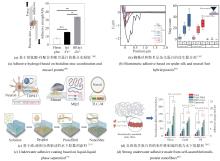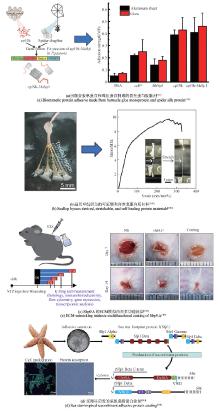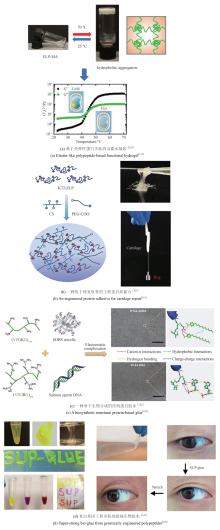|
||
|
Synthetic biology and applications of high-adhesion protein materials
Synthetic Biology Journal
2025, 6 (4):
806-828.
DOI: 10.12211/2096-8280.2025-043
Due to their exceptional bioadhesive properties and potential biocompatibility, high-viscosity protein materials exhibit significant application prospects in the fields of biomedical materials and adhesives. However, traditionally sourced high-viscosity protein materials encounter numerous challenges, including low yields, structural complexity, and difficulties in scaling up production. Synthetic biology, as an emerging interdisciplinary field, offers innovative strategies to address these bottlenecks. This review systematically summarizes recent advances in the biosynthesis, modification, and applications of high-viscosity protein materials, focusing on the advantages of synthetic biology in addressing issues related to the yield, controllability, and functional diversity of these materials. The precise design and efficient expression of adhesive proteins, such as mussel adhesive proteins, barnacle cement proteins, and scallop foot proteins, achieved through genetic engineering, are comprehensively reviewed, demonstrating the overcoming of limitations in the production and controllability of high-viscosity protein materials. Furthermore, the unique advantages of these protein materials in bioadhesives and functional medical coatings, such as the wet adhesion of mussel proteins, the strong adhesion of barnacle cement proteins, and the tunable properties of elastin-like proteins, are summarized. By employing synthetic biology approaches, limitations in the yield, performance, and functionality of high-viscosity protein materials can be overcome, thereby accelerating their application in areas such as tissue engineering and surface modification. Finally, the latest advancements and innovations in the field of synthetic biology for high-viscosity protein materials are summarized, and future development directions are envisioned, offering new ideas and strategies for the development of high-performance, multifunctional high-viscosity protein materials.

Fig. 3
Mussel protein-based medical materials
Extracts from the Article
Mfp凭借其优异的黏附能力和生物相容性在生物医学领域也发挥着重要作用。通过旋涂、浸涂等方法使Mfp在医用材料表面形成涂层,从而改善细胞的黏附、增殖和分化等行为[87]。此外,Mfp还可作为介质材料,将细胞微环境因子、核酸、治疗药物、无机纳米粒子等生物分子固定在靶表面上[88]。然而,由于天然黏性蛋白或重组黏性蛋白组分单一、机械性能不理想,因此,通过设计功能肽或其他重组蛋白与Mfp的融合来实现的复合型黏合材料应运而生。例如,Kin等[89]将抗菌肽(AMP)与Mfp融合,以克服AMP稳定性和毒性限制。研究表明,该融合蛋白是一种具有新型抗菌活性的、热稳定且安全的革兰氏阴性菌抑制剂。此外,Hu等[90]基于聚乙烯吡咯烷酮(PVP)-聚乙二醇丙烯酸酯(PEGDA)的化学交联网络和Mfp-5的物理网络,开发了一种双网络水凝胶涂层(PPM)。得益于Mfp-5的仿生黏附特性和抗菌活性,PPM表现出优异的抗菌能力和超润滑性能[图3(a)]。类似地,Lee等[91]基于Mfp与丝素蛋白(SF)构建了双面电纺纳米纤维止血敷料:内侧含DOPA的Mfp层通过氢键、金属配位等激活血小板并增强凝血,同时提供湿态组织黏附;外侧由于SF的表面特性转换,保护伤口部位免受意外黏附以及包括细菌在内的污染物的渗透。实验验证表明,这种局部多功能双面纳米纤维止血敷料基于两种生物相容性和可生物降解的蛋白质生物材料,在内出血护理应用中具有良好的应用前景[图3(b)]。Cheong等[92]将Mfp与细胞外基质(ECM)中的生物功能肽相结合,通过增强细胞黏附、增殖、神经分化和神经突形成,加速神经再生。为了促进神经和雪旺细胞的接触引导,将Mfp与合成聚合物聚乳酸-羟基乙酸(PLGA)结合,制成电纺对齐纳米纤维导管,以控制溶解度和机械性能。体外和体内实验表明,Mfp的黏附性、ECM肽的整合素介导相互作用以及对齐纳米纤维的接触引导的多维策略协同加速了功能性神经再生。这种基于Mfp的多维方法为神经再生应用(包括神经移植)提供了新的机遇[图3(c)]。
Other Images/Table from this Article
|




